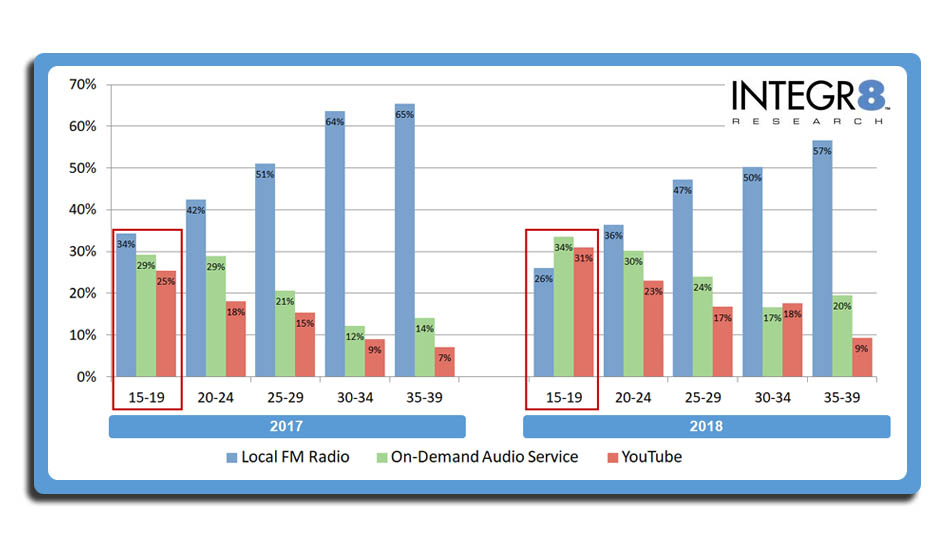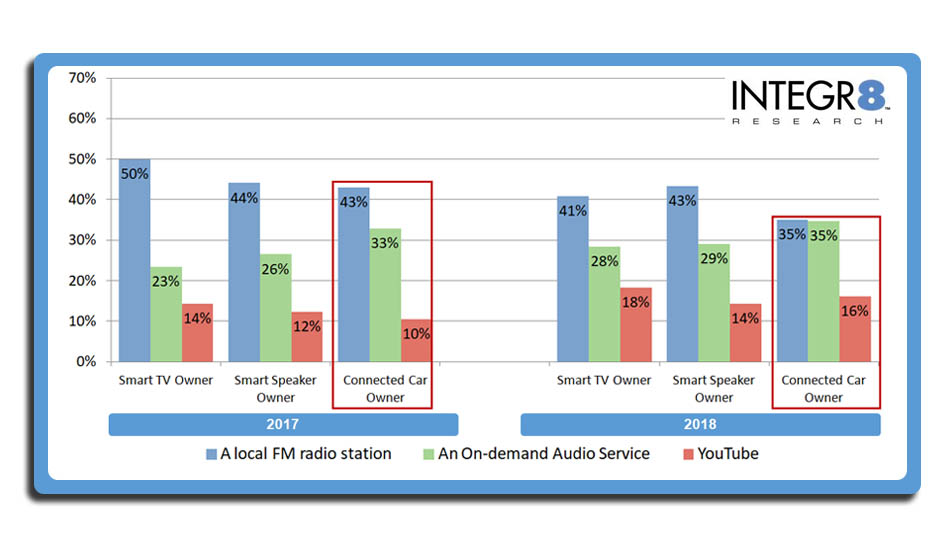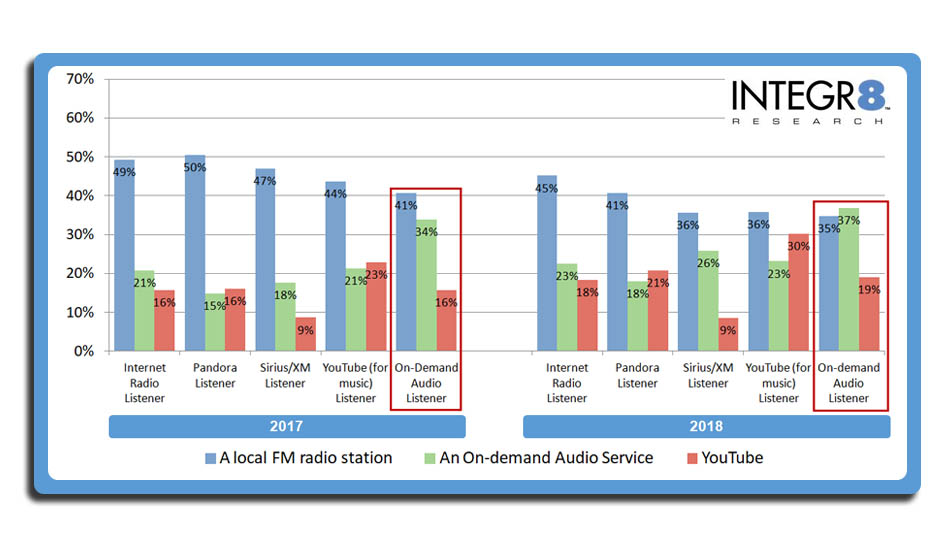In 2017, we identified three groups of listeners who were increasingly turning away from radio and towards on-demand services to find out about the latest music releases, namely:
- Teenagers
- Listeners who regularly use on-demand services such as Spotify
- Listeners who have Apple CarPlay or Android Audio in their car.
We warned that radio would completely surrender its function as the first place to learn about new music among these three groups unless it aggressively promoted its role of introducing listeners to the latest music.
Unfortunately, the trend has not changed course. Radio has now lost its leading role in new music discovery among all three of these groups.
Radio loses teenagers
Among 15- to 19-year-old listeners, local FM radio stations now trail both on-demand audio services and YouTube for the place where teens hear new music first.
However, it’s not just teens who aren’t learning about new music form radio. Back in 2017, the majority of listeners 25 and older still heard new music first on FM radio. Less than two years later, radio now only maintains a solid majority for new music discovery among listeners 35 and older.

Where Listeners Hear New Music First: 2017 vs. 2018
Radio loses connected car owners
Among listeners who own a car with Apple CarPlay or Android Auto, local FM radio is now tied with on-demand audio services for new music discovery. While connected car ownership remains low today, the dramatic impact the connected car could have on music consumption as listeners slowly but surely replace old automobiles is arguably the most existential threat to local radio.
… but smart speaker owners still turn to radio for new music discovery
Additionally, owners of Smart TVs such as Roku, Amazon Fire and Google Chromecast are also decreasingly finding out about the latest new music first from local FM radio. Among the smart devices we examined, only smart speaker owners remain as likely to learn about new music from radio today as they were in 2017:

Where Listeners Hear New Music First: 2017 vs. 2018
Radio loses on-demand users
Finally, Spotify and similar services have now succeeded in usurping radio’s new music discovery role among their regular users. The most troubling part of this development is the rapid growth of Spotify and similar services. Sixty-three percent (63%) of 15- to 39-year-old listeners are already using on-demand audio regularly.

Where Listeners Hear New Music First: 2017 vs. 2018
Should radio even care if people use our stations to discover new music? Aren’t we better off just playing the songs listeners already know and love and let Spotify sort out the hits for us?
For CHR, Urban, Alternative and Country stations, you absolutely should care if listeners think of you for exposing them to new music. In focus groups, listeners consistently cite keeping up to date on the latest music as a key reason they choose a contemporary music station. Perceptual research spotlights that contemporary stations that neglect new music discovery develop bad reputations for being stale and out of touch—negative images that ultimately hamper their long-term ratings performance.
The paradox herein is that, in the moment, listeners usually show more interest in the song they already know and love than for the new song they’re hearing for the first time. As anyone with callout research can tell you, the recurrents rise to the top of the ranker, while the new songs usually debut closer to the bottom. Similarly, M-score, the tool that uses PPM data to identify songs that cause above-average tune-out, commonly shows that listeners are more likely to switch away from an unfamiliar song than from a well-known one.
Back in the diary days, radio was proud of the new music it debuted for its listeners. “Smash or Trash” features ruled nighttime shows and gave listeners a way to engage with the station’s music. Personalities routinely teased an upcoming spin of a brand new song from a core artist. In direct format battles, stations even trash-talked competitors for being slow to add specific titles.
Then came PPM. When stations initially discovered that new songs could cause in-the moment tune-out, we hid them: We played new releases coming out of stop-sets. We buried them in long music sweeps. We stopped teasing new songs. We told our personalities not to talk about new songs. We hoped listeners wouldn’t even notice the new songs we played.
Unfortunately, we got our wish.
Listeners no longer notice the new music they hear first on the radio. On-demand audio services are aggressively pursuing music discovery with new music playlists and features—and listeners are changing their perceptions of these brands because of these efforts—at radio’s expense. Spotify and its clones have already overtaken radio as the place to discover new music among several key listenership groups and, in combination with YouTube, now threatens to overtake radio among everybody under 35.
However, radio has a weapon Spotify will never have—personality:
- A radio personality can tell you the backstory of a breakthrough artist that makes you want to hear her work.
- A radio personality can point out that crazy line in the second verse to stay tuned to hear.
- A radio personality can engage you to smash or trash a song on the station’s social media.
- A radio personality can give you the chance to be among the very first to hear a new song by a star artist.
A radio personality can add context that will make listeners excited to hear a song that otherwise would simply be weird and unfamiliar. It’s a deeply personal and emotionally engaging weapon no algorithm can match. When we stifle their voices and their role in introducing new music simply to avoid potential tune-out, we might win a few tenths of a point in the PPM battle, but we will lose the new music war to Spotify.
How do you think radio’s personalities could engage today’s listeners with new music? Let us know in the comments or on Facebook.
Watch The Alexa Effect Webinar
